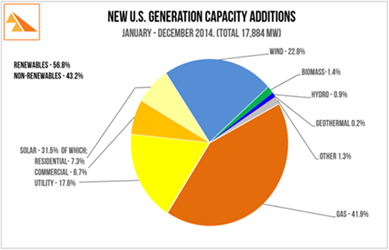
Wind And
Solar Account For 100% Of New U.S. Generating Capacity In April 2015
With wind and solar energy dominating April, renewables
have represented more than 84% of new U.S generating capacity in
2015.
Ken Bossong, Sun Day Campaign, RenewableEnergyWorld.com - May 26, 2015
WASHINGTON D.C. — In what is becoming a frequent occurrence,
if not predictable pattern, renewable energy sources once again dominate in the
latest federal monthly update on new electrical generating capacity brought
into service in the United States.
According to the recently-released "Energy Infrastructure Update" report from the Federal Energy Regulatory Commission's (FERC) Office of Energy
Projects, wind and solar accounted for all
new generating capacity placed in-service in April. For the month,
two "units" of wind (the 300-megawatt (MW) Hereford-2 Wind Farm
Project in Deaf Smith County, TX and the 211MW Mesquite Creek Wind Project in
Dawson County, TX) came on line in addition to six new units — totaling 50MW —
of solar.
Further, wind, solar,
geothermal, and hydropower combined have provided over 84% of the 1,900MW of
new U.S. electrical generating capacity placed into service during the first
third of 2015. This includes 1,170MW of wind (61%), 362MW of solar
(19%), 45MW of geothermal steam (2.4 %), and 21MW of hydropower (1.1 %). The balance
(302MW) was provided by five units of natural gas.
FERC reported no new capacity for this year from biomass
sources nor any from coal, oil, or nuclear.
 The
total contribution of geothermal, hydropower, solar,
and wind for the first four months of 2015 (1,598MW)
is similar to that for the same period in 2014 (1,611MW,
in addition to 116MW of biomass). However, for the
same period in 2014, natural gas added 1,518MW of
new capacity while coal and nuclear again provided
none and oil just 1MW. Renewable energy sources accounted for half of all new
generating capacity added in 2014. The
total contribution of geothermal, hydropower, solar,
and wind for the first four months of 2015 (1,598MW)
is similar to that for the same period in 2014 (1,611MW,
in addition to 116MW of biomass). However, for the
same period in 2014, natural gas added 1,518MW of
new capacity while coal and nuclear again provided
none and oil just 1MW. Renewable energy sources accounted for half of all new
generating capacity added in 2014.
Renewable energy sources now account for 17.05% of total
installed operating generating capacity in the U.S.: water 8.55%, wind 5.74%,
biomass 1.38%, solar 1.05%, and geothermal steam 0.33%(for comparison,
renewables were 13.71% of capacity in December 2010 — the 1st month
FERC "Energy Infrastructure Update").
Renewable energy capacity is now greater than that of
nuclear (9.14 %) and oil (3.92 %) combined. In fact, the installed capacity
of wind power alone has now surpassed that of oil. In addition, total installed
operating generating capacity from solar has now reached and surpassed the 1%
threshold — a ten-fold increase since December 2010.
Note that generating capacity is not the same as actual
generation. Electrical production per MW of available capacity (i.e., capacity
factor) for renewables is often lower than that for fossil fuels and nuclear
power. According to the most recent data (i.e., as of February 2015) provided
by the U.S. Energy Information Administration, actual net electrical generation
from renewable energy sources now totals 13.4% of total US electrical
production; however, this figure almost certainly understates renewables'
actual contribution significantly because neither EIA nor FERC fully accounts
for all electricity generated by distributed renewable energy sources (e.g.,
rooftop solar).
Members of Congress and state legislators proposing to curb
support for renewable energy, such as Renewable Portfolio/Electricity Standards
and the federal Production Tax Credit and Investment Tax Credit, are swimming
against the tide. With renewable energy's clear track record of success and the
ever-worsening threat of climate change, now is not the time to pull back
from these technologies but rather to greatly expand investments in them.

|